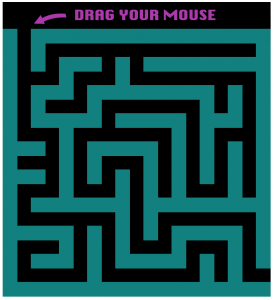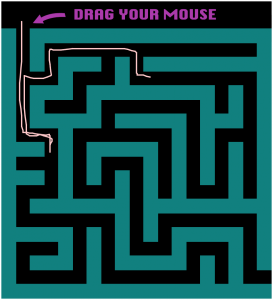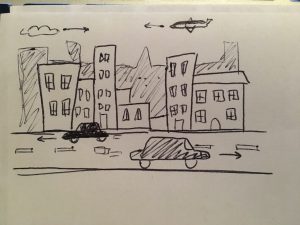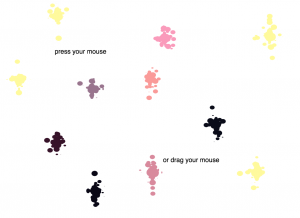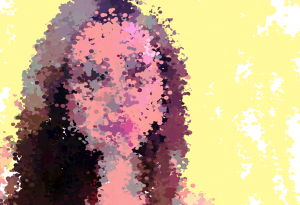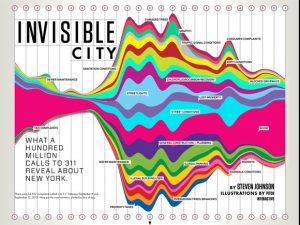For my final project, I created a simple computer game. Going into the assignment, I knew that I wanted to create a game in which you simply were flying and avoiding hitting cliffs above and below you. My game turned into a jetpacker game in which you are going deeper and deeper into a cave.
Please click on the canvas to be able to use the key commands. Press ‘S’ first to start the game and get everything moving. Then, you can use ‘J’ to ignite your jetpack, and to jump upwards. I recommend you hold down ‘J’ for longer strides instead of using short, jerky jump motions. Either way, try to stay alive as long as possible, measured by the seconds alive listed in the top left corner and the background cave color changing as you go deeper into the cave.
var topRocks = [];
var bottomRocks = [];
var count = 0; //will keep track of where on the noise curve we are
var jetPackY; //character's Y location, from top
var flameImg; //character image with flame
var noFlameImg; //character
var monsterImg; //flying monster character
var notPaused = false; //game is paused
var gameOver = false; //game is in play
var initialTime = 0; //time counter variables
var elapsed;
var timeAtDeath = 0;
var colR = 255; //initial background color
var colG = 161;
var colB = 105;
function preload() {
flameImg = loadImage("http://dianaconnolly.me/assets/jetpacker!-01.png");
noFlameImg = loadImage("http://dianaconnolly.me/assets/jetpackerNoFlame-01.png");
}
function setup() {
monsterX = width + 1000;
monsterY = height / 2 - 30;
createCanvas(600, 400);
frameRate(40);
jetPackY = height / 2;
// pushes in noise values into top and bottom rock arrays
while (count < width + 1) {
topRocks.push(height - noise(count * 0.01) * height / 3);
bottomRocks.push(noise(width + count * 0.01) * height / 3);
count++;
}
}
function draw() {
background(colR, colG, colB);
drawBottomRocks();
drawTopRocks();
//prints time alive
fill(255);
textSize(15);
textStyle(BOLD);
textAlign(LEFT);
textFont("Helvetica");
if (!notPaused) {
elapsed = 0;
} else if (gameOver) {
elapsed = timeAtDeath;
} else {
var elapsed = getElapsed();
}
text("Seconds alive: " + elapsed, 15, 25);
//moving background and jetpacker
if (notPaused & !gameOver) {
timeAtDeath = getElapsed();
updateScreen();
monsterX -= 3;
updateBackgroundColor(elapsed);
println("lik");
if (keyIsDown(74)) {
jetPackY -= 5; //start moving jetPack w/ pressing "J"
} else {
jetPackY += 3; //jetPack falls otherwise
}
}
//draw jetPack
var jetPackX = width / 3;
if (keyIsDown(74)) {
image(flameImg, jetPackX, jetPackY, 30, 40);
} else {
image(noFlameImg, jetPackX, jetPackY, 30, 40);
}
if (!notPaused & !gameOver) { //starting page
fill(0);
textSize(20);
textStyle(BOLD);
textAlign(CENTER);
textFont("Helvetica");
text("Press 'S' to start game", width / 2, height / 2 - 10);
text("Hold down 'J' to move up", width / 2, height / 2 + 50);
}
//checks for hitting bottom rocks
var tallestBottomPoint = bottomRocks[jetPackX];
for (var j = jetPackX; j < jetPackX + 30; j++) {
tallestBottomPoint = max(bottomRocks[j], tallestBottomPoint);
}
if (jetPackY + 30 >= height - tallestBottomPoint) {
gameOver = true;
textAlign(CENTER);
textSize(60);
textFont("Helvetica");
fill(255, 0, 0);
text("GAME OVER", width / 2, height / 2);
textSize(20);
fill(0);
text("Press 'R' to start again", width / 2, height / 2 + 40);
}
//checks for hitting top rocks
var tallestTopPoint = height - topRocks[jetPackX];
for (var k = jetPackX; k < jetPackX + 30; k++) {
tallestTopPoint = max(height - topRocks[k], tallestTopPoint);
}
if (jetPackY + 10 <= tallestTopPoint) {
gameOver = true;
textAlign(CENTER);
textSize(60);
textFont("Helvetica");
fill(255, 0, 0);
text("GAME OVER", width / 2, height / 2);
textSize(20);
fill(0);
text("Press 'R' to start again", width / 2, height / 2 + 40);
}
//restart game
if (keyIsPressed) {
if (key == 'r' || key == 'R') {
jetPackY = height / 2;
notPaused = false;
gameOver = false;
}
}
}
function keyPressed() {
// if you press S, start and reset start time
if (key == 's' || key == 'S') {
initialTime = getSecondsToday();
notPaused = true;
}
}
// ----------------------------------------------------------------------------------------
// FUNCTIONS CALLED FROM ABOVE
function drawBottomRocks() {
beginShape();
noStroke();
fill(31, 19, 79);
vertex(0, height);
for (var i = 0; i < bottomRocks.length; i++) {
vertex(i, height - bottomRocks[i]);
}
vertex(width, height);
endShape(CLOSE);
}
function drawTopRocks() {
beginShape();
noStroke();
fill(31, 19, 79);
vertex(0, 0);
for (var i = 0; i < topRocks.length; i++) {
vertex(i, height - topRocks[i]);
}
vertex(width, 0);
endShape(CLOSE);
}
function updateScreen() {
//shifts over mountains based on noise plots
for (var i = 0; i < 5; i++) {
bottomRocks.shift();
topRocks.shift();
count++;
topRocks.push(height - noise(count * 0.01) * height / 2);
bottomRocks.push(noise(width + count * 0.01) * height / 2);
}
}
function getSecondsToday() {
// returns seconds since midnight today
var h = hour();
var m = minute();
var s = second();
return (s) + (m * 60) + (h * 60 * 60);
}
function getElapsed() {
// responsible for returning seconds since game started
return getSecondsToday() - initialTime;
}
function updateBackgroundColor(elapsed) {
//shifts background color
colR = map(elapsed, 0, 20, 255, 227);
colG = map(elapsed, 0, 20, 161, 167);
colB = map(elapsed, 0, 20, 105, 193);
}![[OLD – FALL 2016] 15-104 • COMPUTING for CREATIVE PRACTICE](../../wp-content/uploads/2020/08/stop-banner.png)

